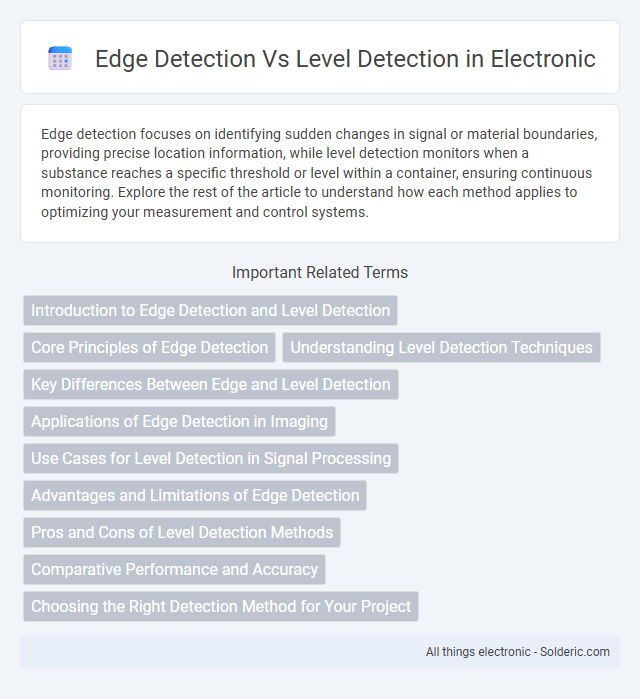Edge detection focuses on identifying sudden changes in signal or material boundaries, providing precise location information, while level detection monitors when a substance reaches a specific threshold or level within a container, ensuring continuous monitoring. Explore the rest of the article to understand how each method applies to optimizing your measurement and control systems.
Comparison Table
| Feature | Edge Detection | Level Detection |
|---|---|---|
| Purpose | Identify changes or boundaries in a signal or image | Measure the continuous value or height of a substance |
| Application | Image processing, signal analysis, robotics | Industrial tanks, reservoirs, process control |
| Measurement | Detects transitions (rising/falling edges) | Measures absolute level or volume |
| Sensor Types | Photo sensors, ultrasonic, capacitive sensors (for edges) | Ultrasonic, radar, float, capacitive, radar sensors |
| Output Type | Binary or pulse signals indicating edges | Continuous analog or digital signals indicating level |
| Use Case Example | Counting items on a conveyor belt | Monitoring liquid height in a tank |
Introduction to Edge Detection and Level Detection
Edge detection identifies boundaries or sudden changes in data, such as material interfaces in sensors, crucial for precise location marking. Level detection monitors continuous levels of substances like liquids or solids, providing constant measurement to prevent overflow or depletion. You can choose edge detection for exact switching points and level detection for ongoing inventory control.
Core Principles of Edge Detection
Edge detection identifies points where there is a significant change in intensity or color in an image, emphasizing boundaries and transitions within the visual data. It utilizes gradient-based techniques such as Sobel, Canny, and Prewitt filters to detect sharp discontinuities in pixel values. These core principles enable the extraction of structural information crucial for object recognition and image segmentation tasks.
Understanding Level Detection Techniques
Level detection techniques are essential for monitoring liquid or solid quantities in various industrial processes, relying on methods such as ultrasonic, capacitive, or radar sensors to measure the precise level of materials within containers. Edge detection algorithms, by contrast, primarily analyze changes in image intensity to identify boundaries but are less suited for direct measurement of physical material levels. Understanding level detection focuses on sensor accuracy, response time, and environmental adaptability to ensure reliable monitoring and control in industries like water treatment, chemical processing, and food production.
Key Differences Between Edge and Level Detection
Edge detection identifies rapid changes or transitions in a signal or material, marking precise boundary points for accurate measurement, while level detection monitors a consistent presence or absence of material at a fixed point, indicating whether the level has reached a predefined threshold. Edge detection is commonly used in applications requiring exact position tracking, such as counting or profiling, whereas level detection is suited for controlling liquid or solid levels in tanks and silos. The fundamental difference lies in edge detection's focus on changes and level detection's emphasis on steady state conditions.
Applications of Edge Detection in Imaging
Edge detection plays a crucial role in imaging applications such as object recognition, image segmentation, and computer vision, enabling precise identification of boundaries within images. This technique enhances image analysis in medical imaging, robotics, and facial recognition systems by detecting discontinuities in intensity or color. Your ability to extract meaningful features for further processing relies heavily on accurate and efficient edge detection algorithms.
Use Cases for Level Detection in Signal Processing
Level detection in signal processing is crucial for applications such as audio compression, where maintaining consistent volume levels prevents distortion and enhances clarity. It also plays a pivotal role in automatic gain control systems, which adjust signal amplitude to optimize performance in telecommunications and broadcasting. Moreover, level detection is essential in noise gate circuits, enabling selective signal suppression to improve audio quality by eliminating unwanted background noise.
Advantages and Limitations of Edge Detection
Edge detection offers precise identification of material boundaries by detecting sudden changes in signal amplitude, making it highly effective in industries requiring accurate interface measurements such as liquid level monitoring in tanks. Its advantages include fast response time and high sensitivity to interface changes, allowing for real-time control and automation. Limitations arise due to signal noise susceptibility, difficulties in detecting small or fuzzy interfaces, and challenges in handling multi-layered or stratified liquids where multiple edges may appear simultaneously.
Pros and Cons of Level Detection Methods
Level detection methods provide continuous and accurate measurement of liquid or solid levels, enabling precise control in industrial processes. These techniques, such as ultrasonic, radar, and capacitive sensors, offer high reliability with minimal maintenance but may face challenges with foam, turbulence, or varying material properties. You should consider environmental conditions and the specific application requirements to select the most suitable level detection method.
Comparative Performance and Accuracy
Edge detection techniques excel in identifying precise boundaries and abrupt changes in images, offering high accuracy in object recognition tasks and image segmentation. Level detection methods, while effective for monitoring continuous changes and maintaining stability in industrial processes, often provide less spatial precision compared to edge detection. Your choice between these methods should consider the specific application requirements, balancing the need for sharp detail detection against consistent level monitoring in dynamic environments.
Choosing the Right Detection Method for Your Project
Edge detection identifies precise changes in a physical parameter, making it ideal for projects requiring accurate point-level sensing, such as liquid interface monitoring in tanks. Level detection continuously measures the quantity or height of a material, suitable for applications needing ongoing feedback, like inventory tracking in silos. Your project's requirements for accuracy, type of material, and environmental conditions will determine whether edge detection or level detection is the optimal solution.
Edge detection vs Level detection Infographic

 solderic.com
solderic.com